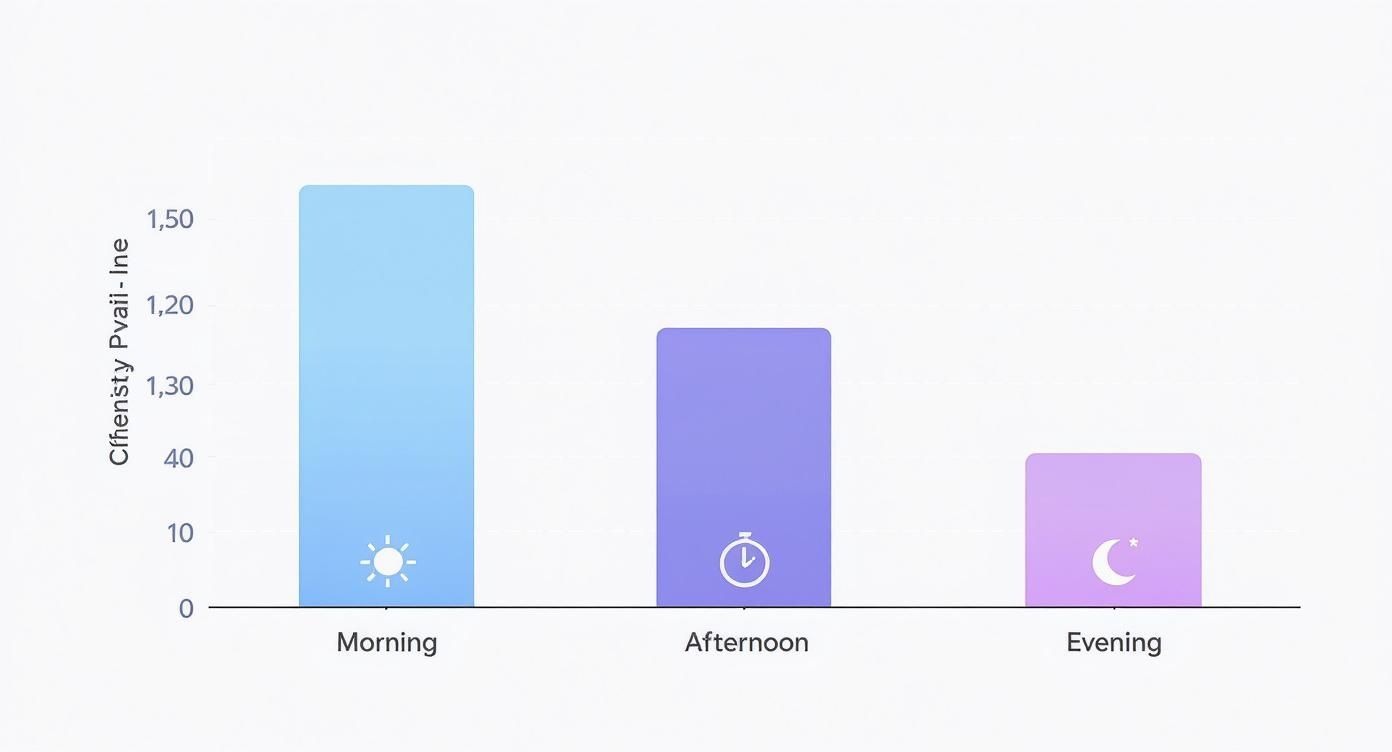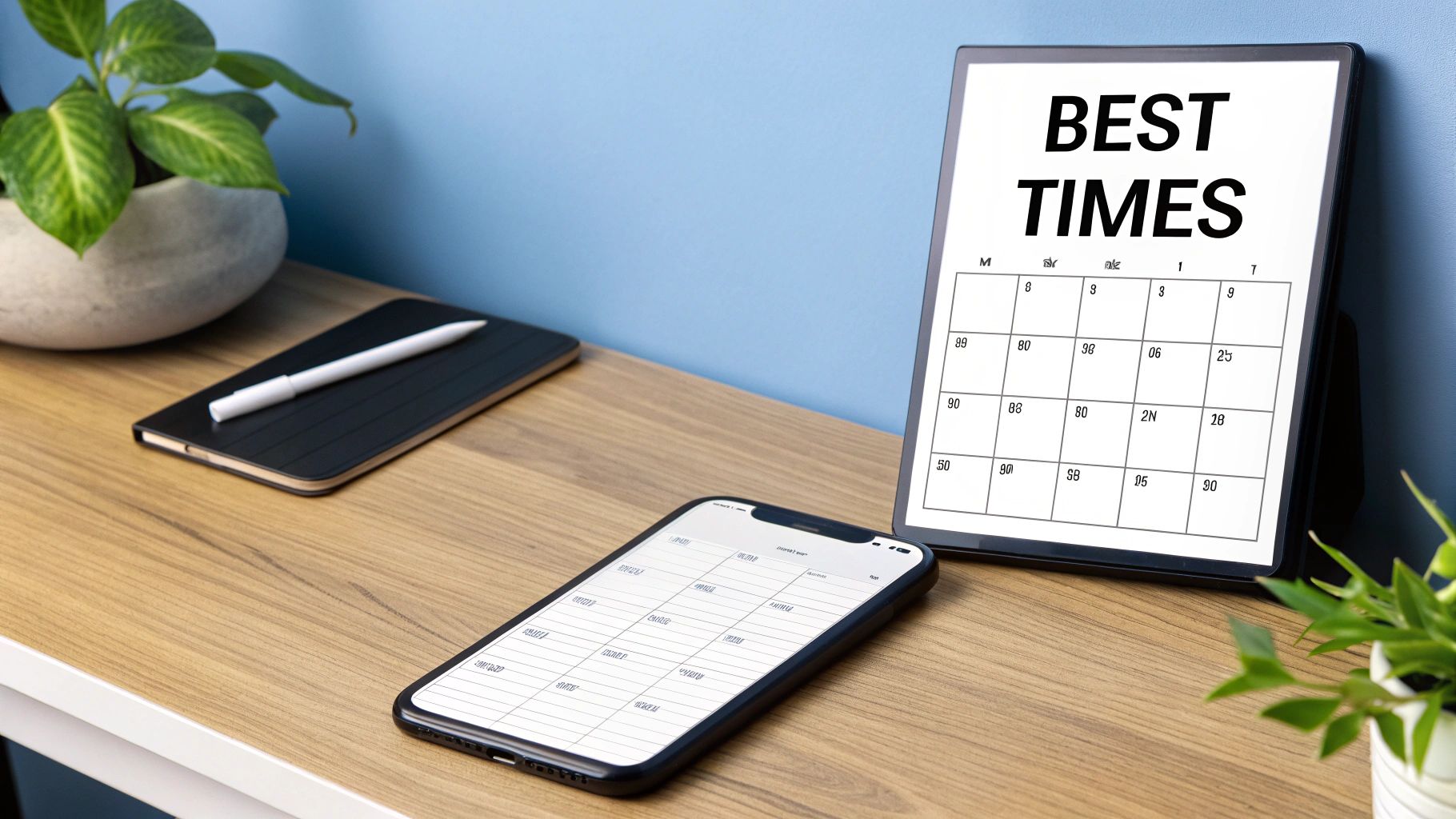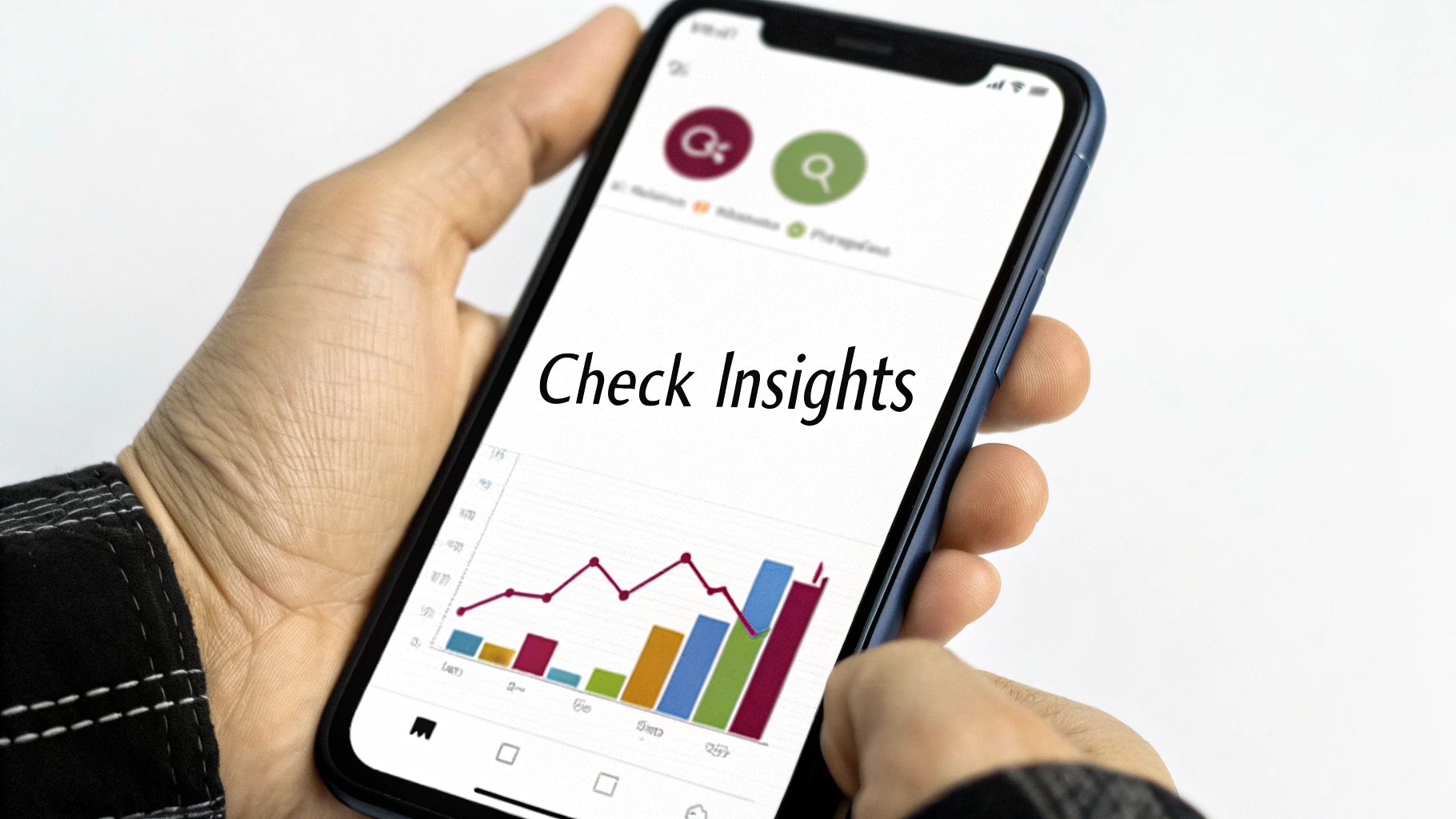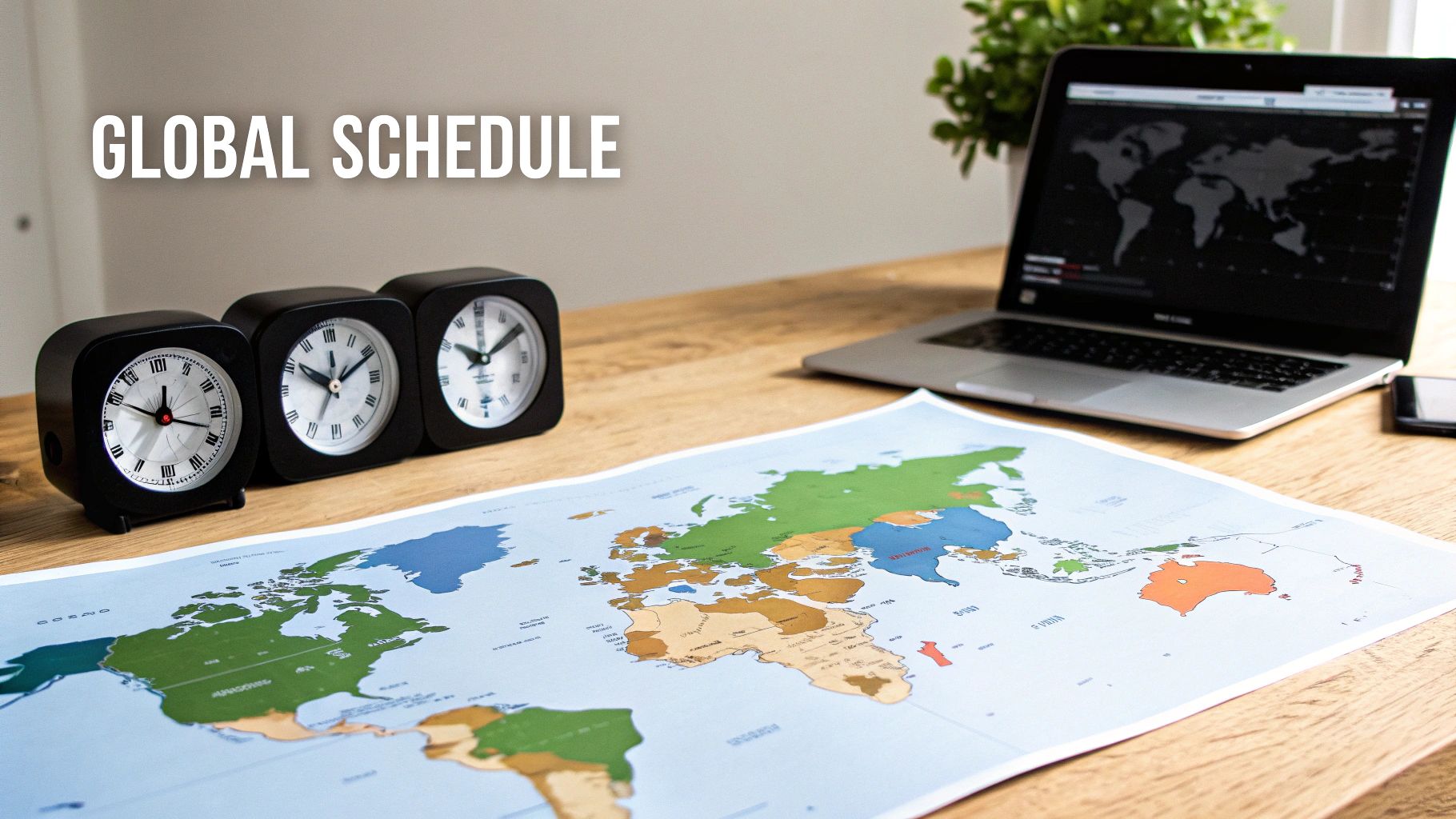Everyone wants to know the secret sauce: when is the perfect time to post on Instagram?
The short answer is, it depends. But the long answer is a lot more helpful. While your brand's ideal time is unique, massive industry studies have crunched the numbers, and they all point to some pretty clear patterns. Think of these as your starting line, not the finish line.
The most common high-engagement windows tend to be between 11 AM and 1 PM and again in the evening from 7 PM to 9 PM on weekdays. It just makes sense, right? This is when most people are taking a lunch break or winding down for the day, scrolling through their feeds.
Data-Backed Starting Points
Let's get straight to it. You can throw spaghetti at the wall and hope it sticks, or you can use data to make an educated guess. The goal is simple: post when the highest number of your followers are actually online and ready to like, comment, and share.
It all boils down to daily routines. We're creatures of habit. People check their phones during their morning commute, over their lunch sandwich, and while kicking back on the couch after work. If you time your posts to hit these natural lulls in the day, you're putting your content in the pole position for engagement.
The real trick is to sync your content calendar with your audience's daily rhythm. You want to be there right when they show up to the party.
This infographic breaks down those general high-traffic periods visually, showing you the ebb and flow of user activity throughout the day.

As you can see, things really start to pick up in the afternoon and early evening. This is prime time, capturing people as their workday focus shifts to personal time.
What The Studies Say
One huge study analyzed over 2 million Instagram posts and found that the sweet spot on weekdays was between 3 PM and 6 PM local time. Why? These hours consistently delivered the best reach, especially for brands targeting the 18-34 age demographic—Instagram's largest user base. It's the "just finished work, time to scroll" effect in action.
While Instagram has its own unique cadence, it helps to understand the broader context. Take a look at this guide on the best times to post on social media in general to see how different platforms compare.
General Best Times to Post on Instagram (Local Time)
To give you a practical starting point, we've compiled the most common high-engagement windows based on aggregated industry research. Use these recommendations to build your initial schedule and test what works for your audience.
| Day of the Week | Primary Window | Secondary Window |
|---|---|---|
| Monday | 12:00 PM | 5:00 PM |
| Tuesday | 9:00 AM | 6:00 PM |
| Wednesday | 11:00 AM | 3:00 PM |
| Thursday | 12:00 PM | 7:00 PM |
| Friday | 10:00 AM | 2:00 PM |
| Saturday | 9:00 AM | 11:00 AM |
| Sunday | 7:00 PM | 8:00 PM |
Remember, this table is a fantastic launchpad. The next step is to dive into your own analytics to see when your specific followers are most active. That's where the real magic happens.
Why the Instagram Algorithm Cares So Much About When You Post
Have you ever spent hours crafting the perfect post, only to hit "Share" and hear crickets? It’s a frustrating feeling, and the problem often isn't your content—it's your timing. Figuring out what time is best to post on Instagram is less about a magic formula and more about learning to work with the platform's algorithm, not against it.
Think of it like this: every new post is a snowball at the very top of a hill. The moment you publish, the Instagram algorithm gives it a tiny nudge, showing it to a small group of your most loyal followers. What happens in that first hour is everything.

If that post immediately starts racking up likes, comments, shares, and saves, the algorithm takes notice. It sees this as a sign of high-quality, engaging content. This initial traction is like a hard shove that sends your snowball barreling down the hill, picking up speed and size along the way.
It's All About "Initial Velocity"
In the marketing world, we call this concept "initial velocity." A post that gets a burst of engagement right out of the gate is rewarded with more visibility. The algorithm basically says, "Oh, people are loving this!" and starts showing it to a wider circle of your followers. If the engagement keeps coming, your post might even land on the Explore page or top hashtag feeds.
On the flip side, if you post when your audience is sleeping, commuting, or just busy, your content gets crickets. That snowball just sits at the top of the hill, melting. The algorithm interprets that silence as a sign of uninteresting content and quickly shoves your post down the feed where it’s unlikely to be seen.
Timing isn’t just a scheduling hack; it’s the trigger for a powerful feedback loop that can dramatically amplify your reach. Good timing sparks early engagement, which signals value to the algorithm, which then rewards you with even more reach.
This is exactly why generic advice like "post at 3 PM on a Monday" often falls flat. That might be a great time for some brands, but if your audience is made up of night-shift nurses or college students who sleep in, that time slot is totally useless for you. The real goal is to sync up your posting schedule with the unique daily rhythm of your followers.
How Good Timing Builds Long-Term Momentum
Getting your timing right creates a ripple effect that goes way beyond a single post. When you consistently publish content when your audience is ready and waiting, you start to train the algorithm to expect high engagement from your account. Over time, this can lift the performance of everything you post.
Here’s a look at how that momentum builds:
- More Early Engagement: Posting when people are actually online means more of your followers see your content fresh out of the gate, leading to a spike in those crucial first-hour likes and comments.
- Stronger Algorithm Signals: This flurry of activity sends a clear message to the algorithm: "This is good stuff, show it to more people!"
- Wider Reach: The algorithm obliges, pushing your post out to a bigger slice of your audience and even to non-followers through the Explore page and hashtags.
- Real Follower Growth: This extra visibility puts your content in front of new people who are genuinely interested in what you do, helping you grow your community.
Ultimately, knowing the best time to post on Instagram isn’t about finding one secret hour. It's about understanding your audience’s habits. It’s the difference between shouting into an empty auditorium and having a conversation with a packed, attentive crowd. When you master your timing, you give every single piece of content its best shot at success.
How to Find Your Personal Best Time to Post
While industry benchmarks give you a fantastic head start, the real truth is buried in your own account’s data. Think of general advice as a map—it shows you the terrain. But your Instagram Insights is the "you are here" pin. This is where you graduate from making educated guesses to making truly data-driven decisions.
It’s all about understanding that your followers aren’t just a number; they're a unique community with their own digital rhythm. An account followed by freelance artists who work late is going to have a completely different activity pattern than one followed by corporate execs who are up at the crack of dawn. Your data is the key to unlocking their specific schedule.
Unlocking Your Audience Data with Instagram Insights
The good news? Instagram gives you a powerful, built-in analytics tool that shows you exactly when your followers are most active. You don't need to shell out for expensive software to get started; the answer is just a few taps away.
To get to this goldmine, you'll first need a Business or Creator account. If you have that set up, here’s the simple path to your data:
- Head over to your main Instagram profile page.
- Tap the "Professional Dashboard" button sitting right under your bio.
- From there, tap on "Total Followers."
- Scroll all the way down to find the "Most Active Times" chart.
This chart is your secret weapon. It gives you a day-by-day and hour-by-hour breakdown of when your specific audience is online and scrolling. It's the clearest picture you'll ever get of peak activity for your community.
The darker blue bars in the chart represent the hours when the highest concentration of your followers are active. These are your prime candidates for posting.
But keep in mind, you're not the only one seeing this. A massive analysis of over 6 million posts found that while obvious times like early morning (7–9 a.m.) and lunchtime (11 a.m.–1 p.m.) are popular, the most successful accounts are the ones who consistently test and refine their schedules.
Putting Your Data to the Test
Okay, so you've found your potential "best times" from Insights. What now? The next step is to see if they hold up in the real world. This is simpler than it sounds. The goal is to compare a few of these high-potential time slots to see which one consistently delivers the best results.
Start by picking two of your peak times—let's say 9 a.m. on Tuesday and 6 p.m. on Thursday. For one week, post your content at the first time slot. The next week, post similar content at the second time slot.
Think of this as a friendly competition. You're letting your peak hours go head-to-head to see which one delivers a stronger punch in terms of likes, comments, and reach.
Now, let's get organized with some A/B testing. This helps you track everything clearly so you can spot the real winner.
A/B Testing Your Instagram Post Times
Here's a simple schedule you can use to test two high-potential posting times and figure out your audience's sweet spot.
| Week | Test Time A (e.g., 9 AM) | Metrics (Reach, Likes) | Test Time B (e.g., 5 PM) | Metrics (Reach, Likes) |
|---|---|---|---|---|
| Week 1 | Post at 9 AM on Tue/Thur/Sat | Track performance | ||
| Week 2 | Post at 5 PM on Tue/Thur/Sat | Track performance | ||
| Week 3 | Post at 9 AM on Tue/Thur/Sat | Track performance | ||
| Week 4 | Post at 5 PM on Tue/Thur/Sat | Track performance |
After a few weeks of this, a clear winner will likely emerge. Pay close attention to key social media engagement metrics like how much reach you get and how many comments roll in during that first critical hour after posting.
This methodical approach removes all the guesswork. You'll end up with a personalized posting schedule that is perfectly synced with your audience’s habits, giving you the definitive answer to what time is best to post on Instagram for your account.
Adjusting Your Schedule for Different Content Types

Let's be honest, not all Instagram content is the same, so why would you post it all at the same time? A quick, hilarious Reel and a detailed, multi-slide Carousel serve completely different purposes. Lumping them together is like trying to serve a five-course dinner during a morning coffee rush—the timing is just all wrong.
To really get your schedule working for you, you have to think about matching the type of content you're posting with your audience's daily routine. The real goal here is to give people the right kind of value at the exact moment they're ready to receive it.
Matching Content to Audience Behavior
Think about how you scroll through Instagram. When are you looking for a quick laugh, and when are you actually ready to sit down and learn something? Your audience is no different. They have predictable patterns you can tap into.
-
Reels for Quick Entertainment: Short, snappy videos are made for easy watching. They're perfect for those little gaps in the day. Try scheduling your Reels during morning commutes (7-9 AM), lunch breaks (12-1 PM), and that late-afternoon slump (3-4 PM) when everyone needs a quick distraction.
-
Carousels and In-Depth Posts for Learning: Content that demands more brainpower—like detailed tutorials, deep-dive infographics, or long, thoughtful captions—does best when your audience has a moment to breathe. Post these in the evenings, from 7-9 PM, when people are unwinding and more willing to spend a few extra minutes absorbing good information.
-
Stories for Immediate Connection: Stories are all about what's happening right now. Since they disappear after 24 hours, you should post them consistently throughout the day, especially during your audience's peak active hours. This keeps you top-of-mind and encourages steady interaction.
The core idea is simple: Align the mental energy required by your content with the mental energy your audience has at that moment. Quick entertainment fits into busy schedules, while deeper content needs dedicated downtime.
Thinking this way gives you a much more sophisticated answer to the question, "what time is best to post on Instagram?" It's not just about one time, but several. These same ideas about scheduling and automation apply to other platforms, too, like when you're using creative TikTok automation strategies to grow your channel.
By breaking up your schedule based on content type, you give every single post its best shot at success. You're no longer just posting at a "good time"—you're posting the right content at the perfect time.
Scheduling Strategies for a Global Audience
So, what happens when your audience isn't all in one neat time zone? Posting at 9 AM in New York is the middle of the night for your followers in Sydney. Honestly, this is a fantastic problem to have—it means your brand has international reach. But it definitely throws a wrench in the works when you're trying to figure out the best time to post on Instagram for everyone.
The trick is to stop hunting for a single "best time" and start thinking in terms of strategic windows that hit multiple regions at once. It's a mindset shift, moving from a local focus to a global one where you’re looking for the sweet spots where time zones overlap.
Mastering Overlapping Time Zones
The most effective way to do this is to target what a lot of social media pros call "straddle hours." These are specific times that catch peak activity in several major time zones at the same time. Think of it as finding the perfect moment where the morning scrollers in one part of the world cross paths with the evening wind-down crowd in another.
A deep dive into over a million social posts showed just how much of a difference this can make. For example, posting windows like 3 p.m. to 9 p.m. on Mondays or 5 a.m. to 8 a.m. on Tuesdays have been shown to be incredibly effective at capturing both Eastern and Western audiences. This is a game-changer for creators who simply can't post around the clock for every single market.
Using Data to Find Your Straddle Hours
Your own Instagram Insights is the best place to begin this treasure hunt. Just navigate to your audience analytics and check out the "Top Locations" section. This will show you exactly where your followers are. Pinpoint your top three to five cities or countries.
Once you know where your people are, you can map out their time zones and start looking for those logical overlaps.
- Example: Let's say your audience is split between Los Angeles (PST) and London (GMT). If you post around 12 PM PST, it's 8 PM GMT. With one post, you've just caught the West Coast lunch crowd and the UK audience scrolling before bed.
Don't drive yourself crazy trying to be perfect for every single time zone. The real goal is to maximize your impact across your most important audience groups. You're aiming for strategic coverage, not total global saturation with every post.
Juggling this complex mix of content, time zones, and schedules really calls for a solid plan. For many, learning how to create an editorial calendar is the key to staying consistent and organized with a global presence.
Ultimately, serving a worldwide audience means you have to lean on automation. A good scheduling tool will become your best friend, letting you plan and queue up content well in advance. Our guide on how to schedule social media posts can walk you through setting up a system that works around the clock—so you don’t have to.
Common Posting Time Mistakes You Need to Avoid

Figuring out the best time to post on Instagram is a huge win, but it's surprisingly easy to fall into a few common traps that can quietly undo all your hard work. Think of these mistakes as engagement leaks—they slowly drain your post's potential without you even noticing.
One of the biggest pitfalls I see is the "set it and forget it" mindset. You do the research, find a time that works, and then stick with it religiously for months, or even years. The problem is, your audience's habits aren't static. They change with the seasons, holidays, and just the general rhythm of their lives. What crushed it for you last quarter might be a dead zone today.
Another classic mistake is forgetting about time zones. Posting at 5 PM your time might feel like the perfect end-of-day slot, but if a huge chunk of your audience is six hours ahead, you're catching them right as they're going to bed.
Staying Ahead of the Pitfalls
To sidestep these issues, you need to treat your posting schedule like a living, breathing part of your strategy—not some static rule you carved in stone. A little bit of ongoing maintenance makes all the difference.
Here are three simple habits you can build to keep your schedule perfectly tuned:
- Review Your Insights Monthly: Get into the habit of pulling up your "Most Active Times" chart in Instagram Insights at the start of every month. It’s a five-minute check-in that keeps your schedule aligned with your audience's real-time behavior.
- Check Your Follower Geography: Take a look at your audience’s "Top Locations." If you have a significant following in another country, you're leaving engagement on the table. You might need a secondary posting schedule or find a "straddle hour" that works for both locations.
- Prioritize Consistency Over Everything: An all-over-the-place schedule is a nightmare for the algorithm. It's far better to post three times a week at your proven peak times than to post seven times a week at completely random hours.
The goal isn't just to find the best time to post once; it's to build a flexible system that keeps you in sync with your audience for the long haul. Dodging these mistakes ensures your content consistently gets the initial traction it needs to fly.
Got Questions About Instagram Posting Times? We've Got Answers.
Once you start digging into your analytics and refining your posting strategy, a few common questions always seem to come up. Let's tackle them head-on so you can build your schedule with confidence.
How Often Should I Post on Instagram?
Honestly, consistency beats frequency every single time. It's far better to publish 3-5 genuinely great posts per week during your peak engagement windows than it is to scramble and put out seven mediocre ones at random times. The Instagram algorithm really values a predictable, steady presence.
Think of it this way: your goal is to become a reliable and welcome part of your followers' daily scroll. Use your best posting times as the building blocks for a content calendar you can actually maintain without burning out.
Do I Really Need a Scheduling Tool?
You can absolutely post manually, but I'll be blunt: a scheduling tool will completely change your workflow for the better. Platforms like Buffer or Later let you batch-create your content ahead of time, ensuring you never miss that perfect moment to post.
This is a non-negotiable if your audience is most active at an inconvenient time for you (like during dinner or in the middle of the night). A scheduler is your 24/7 assistant, making it a wise move for any serious creator or business.
What If My Audience Is Most Active While I'm Asleep?
This is precisely where scheduling tools become your best friend. Let's say your Instagram Insights show a huge spike in activity from your European followers at what is 3 AM your time. No problem.
You can craft the perfect post during your working hours, then simply tell your scheduling tool to send it live while you're sleeping. This way, your content gets that critical initial wave of likes and comments right as it's published, giving it the best possible chance to perform well—all without you setting a single alarm.
Ready to stop worrying about time zones and start posting on autopilot? EvergreenFeed helps you schedule your best content effortlessly. Save hours of manual work and keep your audience engaged around the clock. Start automating your evergreen content for free!




